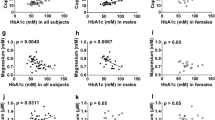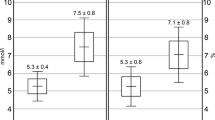Abstract
A growing understanding of antioxidant mechanisms and insulin-like actions of trace elements selenium and zinc has rekindled researchers’ interest towards their role in diabetes mellitus, nutritional management of which concentrates predominantly on macronutrient intake. However, selenium studies limiting largely to diabetes have yielded inconsistent results with sparse knowledge in the pre-diabetes population. This hospital-based cross-sectional study screened 300 people who came to the institutional hospital laboratory with fasting plasma glucose and glycosylated haemoglobin requisition over a period of 6 months. Thirty-five pre-diabetes subjects aged 25–45 years and 35 age-matched healthy controls were selected as per inclusion criteria and clinical history. Serum selenium was estimated by inductively coupled plasma-mass spectrometry, zinc and magnesium by colorimetric end-point methods and insulin by enzyme-linked immunosorbent assay, and insulin resistance was calculated using a homeostasis model assessment (HOMA) 2 calculator. Data analysis was done using SPSS ver. 16 employing an independent sample t test for intergroup comparison of means and Pearson’s correlation for correlation analysis. Serum mineral levels in the pre-diabetes group (selenium 63.01 ± 17.6 μg/L, zinc 55.78 ± 13.49 μg/dL, magnesium 1.37 ± 0.38 mg/dL) were significantly reduced (p < 0.05) in comparison to the healthy controls (selenium 90.98 ± 15.81 μg/L, zinc 94.53 ± 15.41 μg/dL, magnesium 2.12 ± 0.22 mg/dL). A significant negative correlation was seen with glycaemic indices and insulin resistance. This study conducted in pre-diabetes subjects highlights a considerable deficiency of serum selenium, zinc and magnesium observed at a much earlier pre-clinical phase. This coupled with the evidence of a strong inverse association with glycaemic indices and insulin resistance postulates the role of mineral alterations in the pathophysiology of hyperglycaemia and insulin resistance.



Similar content being viewed by others
References
Guerrero RF, Rascón RA, Rodríguez MM, Peña JE, Wacher N (2008) Hypomagnesaemia and risk for metabolic glucose disorders: a 10-year follow-up study. Eur J Clin Investig 38(6):389–396
Chinyere NA, Opera UA, Henrietta EM, Nathaniel UI (2005) Serum and urine levels of chromium and magnesium in type 2 diabetics in Calabar, Nigeria. Mal J Nutr 11(2):133–142
Ahn B-I, Kim MJ, Koo HS, Seo N, Joo N-S, Kim Y-S (2014) Serum zinc concentration is inversely associated with insulin resistance but not related with metabolic syndrome in nondiabetic Korean adults. Biol Trace Elem Res 160:169–175
Gao H, Hagg S, Sjogren P, Lambert PC, Ingelsson E, Dam RM (2014) Serum selenium in relation to measures of glucose metabolism and incidence of type 2 diabetes in an older Swedish population. Diabet Med 31(7):787–793
Steinbrenner H, Speckmann B, Pinto A, Sies H (2011) High selenium intake and increased diabetes risk: experimental evidence for interplay between selenium and carbohydrate metabolism. J Clin Biochem Nutr 48(1):40–45
Rayman MP (2012) Selenium and human health. Lancet 379(9822):1256–1268
Akbaraly TN, Arnaud J, Rayman MP, Hininger-Favier I, Roussel AM (2010) Plasma selenium and risk of dysglycemia in an elderly French population: results from the prospective Epidemiology of Vascular Ageing Study. Nutr Metab (Lond) 7:21–27
Laclaustra M, Navas-Acien A, Stranges S, Ordovas JM, Guallar E (2009) Serum selenium concentrations and diabetes in U.S. adults: National Health and Nutrition Examination Survey (NHANES) 2003–2004. Environ Health Perspect 117:1409–1413
Czernichow S, Couthouis A, Bertrais S, Vergnaud AC, Dauchet L, Galan P, Hercberg S (2006) Antioxidant supplementation does not affect fasting plasma glucose in the supplementation with antioxidant vitamins and minerals (SU.VI.MAX) study in France: association with dietary intake and plasma concentrations. Am J Clin Nutr 84:395–399
Hruby A, Meigs JB, O’Donnell CJ, Jacques PF, McKeown NM (2014) Higher magnesium intake reduces risk of impaired glucose and insulin metabolism and progression from prediabetes to diabetes in middle-aged americans. Diabetes Care 37(2):419–427
Vashum KP, McEvoy M, Milton AH, Islam MR, Hancock S, Attia J (2014) Is serum zinc associated with pancreatic beta cell function and insulin sensitivity in pre-diabetic and normal individuals? Findings from the Hunter Community study. PLoS One 9:e83944
Wiernsperger N, Rapin J (2010) Trace elements in glucometabolic disorders: an update. Diabetol Metab Syndr 2:70
Farid SM, Abulfaraj TG (2013) Trace mineral status related to levels of glycated haemoglobin of type 2 diabetic subjects in Jeddah, Saudi Arabia. Med J Islam World Acad Sci 21(2):47–56
Naila M, Hussain BG, Ahmed GR, Ahmed MI, Muhammad A, Sadik MM (2009) Serum zinc and magnesium in type 2 diabetic patients. J Coll Physicians Surg Pak 19(8):483–486
Kim DJ, Xun P, Liu K, et al. (2010) Magnesium intake in relation to systemic inflammation, insulin resistance, and the incidence of diabetes. Diabetes Care 33:2604–2610
Zeyda M, Stulnig TM (2009) Obesity, inflammation, and insulin resistance—a mini-review. Gerontology 55:379–386
American Diabetes Association (2012) Standards of medical care in diabetes—2012. Diabetes Care 35(1):S11–S63
Serdar M, Bakir F, Hasimi A, Celik T, Akin O, Kenar L (2009) Trace and toxic element patterns in nonsmoker patients with noninsulin-dependent diabetes mellitus, impaired glucose tolerance, and fasting glucose. Int J Diabetes Dev Ctries 29(1):35–40
Kornhauser C, Garcia-Ramirez JR, Wrobel K, Pérez-Luque EL, Garay-Sevilla ME, Wrobel K (2008) Serum selenium and glutathione peroxidase concentrations in type 2 diabetes mellitus patients. Primary Care Diabetes 2(2):81–85
Ozkaya M, Sahin M, Cakal E, Gisi K, Bilge F, Kilinc M (2009) Selenium levels in first-degree relatives of diabetic patients. Biol Trace Elem Res 128:144–151
Islam MR, Arslan I, Attia J, McEvoy M, McElduff P, et al. (2013) Is serum zinc level associated with prediabetes and diabetes?: a cross-sectional study from Bangladesh. PLoS One 8(4):e61776. doi:10.1371/journal.pone.0061776
Sun Q, van Dam RM, Willett WC, Hu FB (2009) Prospective study of zinc intake and risk of type 2 diabetes in women. Diabetes Care 32(4):629–634
Marreiro DN, Geloneze B, Tambascia MA, Lerario AC, Halpern A, Cozzolino SM (2006) Effect of zinc supplementation on serum leptin levels and insulin resistance of obese women. Biol Trace Elem Res 112(2):109–118
Xu J, Zhou Q, Liu G, Tan Y, Cai L (2013) Analysis of serum and urinal copper and zinc in Chinese northeast population with the prediabetes or diabetes with and without complications. Oxidative Med Cell Longev. doi:10.1155/2013/635214
Ilouz R, Kaidanovich O, Gurwitz D, Eldar-Finkelman H (2002) Inhibition of glycogen synthase kinase-3beta by bivalent zinc ions: insight into the insulin-mimetic action of zinc. Biochem Biophys Res Commun 295:102–106
Prasad AS (2008) Clinical, immunological, anti-inflammatory and antioxidant roles of zinc. Exp Gerontol 43:370–377
Hans CP, Sialy R, Bansal DD (2002) Magnesium deficiency and diabetes mellitus. Curr Sci 83:1456–1463
Hans CP, Sialy R, Bansal DD (2002) Hypomagnesemia in diabetic patients: correlation with oxidative stress. Int J Diab Dev Countries 22:122–131
Fang C, Wang X, Wu W, Gu X, Ye T, Deng H (2015) Association of serum magnesium level with odds of prediabetes and diabetes in a southern Chinese population: a prospective nested case-control study. Biol Trace Elem Res. doi:10.1007/s12011-015-0594-y
Guerrero RF, Rodriguez MM (2011) Magnesium improves the beta-cell function to compensate variation of insulin sensitivity: double-blind, randomized clinical trial. Eur J Clin Investig 41:405–410
Xu B, Sun J, Deng X, Huang X, Sun W, Xu Y, Xu M, Lu J, Bi Y (2013) Low serum magnesium level is associated with microalbuminuria in Chinese diabetic patients. Int J Endocrinol 2013:580685
McCarty MF (2005) Magnesium may mediate the favorable impact of whole grains on insulin sensitivity by acting as a mild calcium antagonist. Med Hypotheses 64(3):619–627
Song Y, Hsu YH, Niu T, Manson JE, Buring JE, Liu S (2009) Common genetic variants of the ion channel transient receptor potential membrane melastatin 6 and 7 (TRPM6 and TRPM7), magnesium intake, and risk of type 2 diabetes in women. BMC Med Genet 10:4. doi:10.1186/1471-2350-10-4
Acknowledgments
We gratefully acknowledge the Research Society for the Study of Diabetes in India (letter no. RSSDI/HQ/Grants/2015/37) and the Manipal University (letter no. CR 22850/1.3.2014) for the financial grants for this study. We also acknowledge the facility provided by the Sophisticated Analytical Instruments Facility, IIT Bombay, for the use of ICP-MS instrument for selenium estimation.
Author information
Authors and Affiliations
Corresponding author
Ethics declarations
Conflict of Interest
The authors declare that they have no conflict of interest.
Ethical Approval
All procedures performed in studies involving human participants were in accordance with the ethical standards of the institutional and/or national research committee and with the 1964 Helsinki Declaration and its later amendments or comparable ethical standards. This article does not contain any studies with animals performed by any of the authors.
Informed Consent
Informed consent was obtained from all individual participants included in the study.
Rights and permissions
About this article
Cite this article
Yadav, C., Manjrekar, P.A., Agarwal, A. et al. Association of Serum Selenium, Zinc and Magnesium Levels with Glycaemic Indices and Insulin Resistance in Pre-diabetes: a Cross-Sectional Study from South India. Biol Trace Elem Res 175, 65–71 (2017). https://doi.org/10.1007/s12011-016-0766-4
Received:
Accepted:
Published:
Issue Date:
DOI: https://doi.org/10.1007/s12011-016-0766-4




